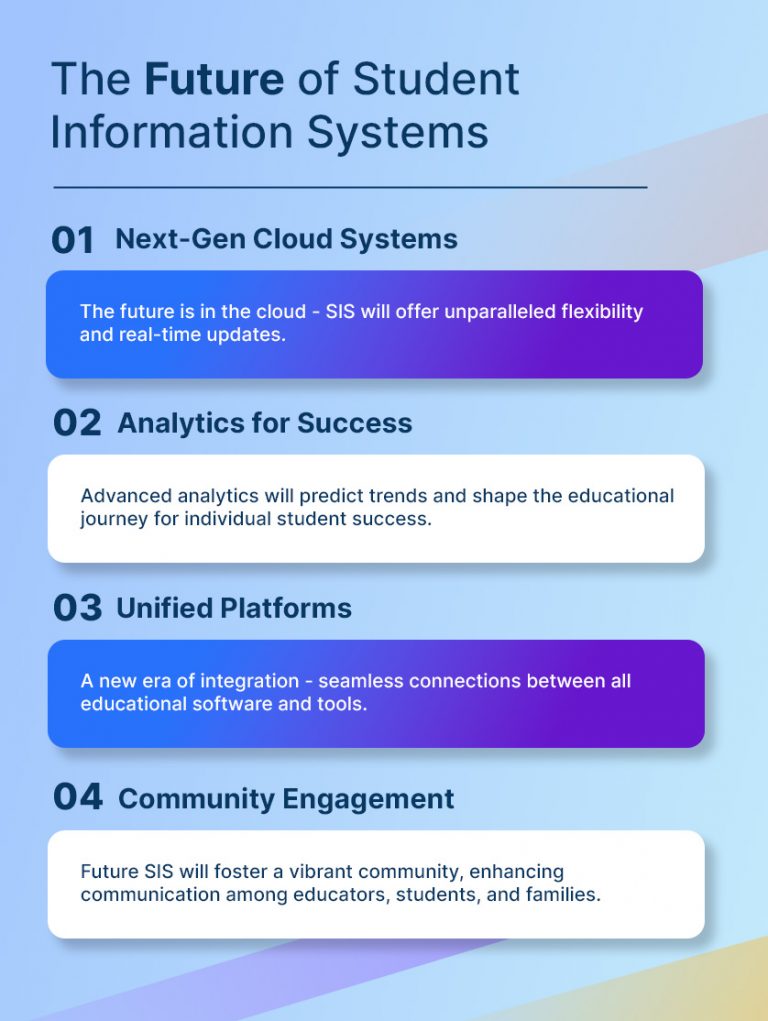Introduction
In the realm of modern education, Student Information Systems (SIS) have become a cornerstone. These systems, often referred to as SIS softwareor student management systems, are transforming schools and educational institutions around the world. This article explores the future of these systems and their relevance to the evolution of educational technology.
Evolution of Student Information Systems
Early Student Management Systems
The early iterations of student management systems were primarily designed to store and manage student data. They were simple databases that held information such as student names, grades, and attendance records.
Modern SIS Software
Today’s SIS software has evolved far beyond basic data storage. Modern systems integrate with other campus information systems, offer advanced student tracking capabilities, and provide enhanced student data management tools.
Key Features of Advanced Student Information Systems
Student Tracking System Capabilities
Advanced SIS software offers robust student tracking systems. These systems allow educators to monitor student progress, identify at-risk students, and implement interventions when necessary.
Integrating Campus Information Systems
Integration with other campus information systems is another key feature of modern SIS software. This integration allows for a more holistic view of student performance and helps educators make informed decisions.
Enhancements in Student Data Management
Modern SIS software also offers enhanced student data management capabilities. These enhancements allow for more efficient data entry, better data accuracy, and improved reporting capabilities.

Future Trends in Student Information Systems
Artificial Intelligence in SIS
Artificial intelligence is set to play a significant role in the future of SIS. AI can help automate routine tasks, provide predictive analytics, and offer personalized learning recommendations.
Cloud-Based Student Database Systems
Cloud-based systems are another future trend in SIS. These systems offer increased accessibility, improved data security, and cost savings.
Predictive Analytics in Student Management
Predictive analytics is another trend to watch. This technology can help identify trends and patterns in student data, allowing educators to make proactive decisions.
Benefits of Using a Student Information System
Improved Student Data Management
One of the primary benefits of using an SIS is improved student data management. An SIS allows for efficient data entry, accurate record-keeping, and easy access to student information.
Efficient Student Tracking Systems
SIS software also offers efficient student tracking systems. These systems allow educators to monitor student progress and intervene when necessary.
Enhanced Communication via SIS for Schools
Finally, an SIS can enhance communication between educators, students, and parents. This improved communication can lead to better student outcomes and a more engaged school community.
Q/A
What is a Student Information System (SIS)?
A Student Information System (SIS) is a software application that allows educational institutions to manage student data. It provides capabilities for registering students in courses, documenting grading, transcripts, results of student tests and other assessment scores, building student schedules, tracking student attendance, and managing many other student-related data needs in a school.
What are the benefits of using a Student Information System?
The benefits of using a Student Information System include improved student data management, efficient student tracking systems, and enhanced communication between educators, students, and parents.
How does an SIS differ from a traditional Student Management System?
While both systems are designed to manage student data, an SIS offers more advanced features, including integration with other campus information systems, advanced student tracking capabilities, and enhanced student data management tools.
What are some key features to look for in an SIS software?
Key features to look for in SIS Software include robust student tracking systems, integration capabilities with other campus information systems, and enhanced student data management tools.
What are the challenges of implementing a Student Information System?
Challenges of implementing a Student Information System can include data migration issues, user training, system customization, and integration with existing systems.
How is artificial intelligence being integrated into Student Information Systems?
Artificial intelligence is being integrated into Student Information Systems in several ways, including automating routine tasks, providing predictive analytics, and offering personalized learning recommendations.
What is the future of Student Information Systems in education?
The future of Student Information Systems in education is likely to be shaped by advancements in technology such as artificial intelligence and cloud computing. These technologies can help automate tasks, provide predictive analytics, and offer personalized learning recommendations.
